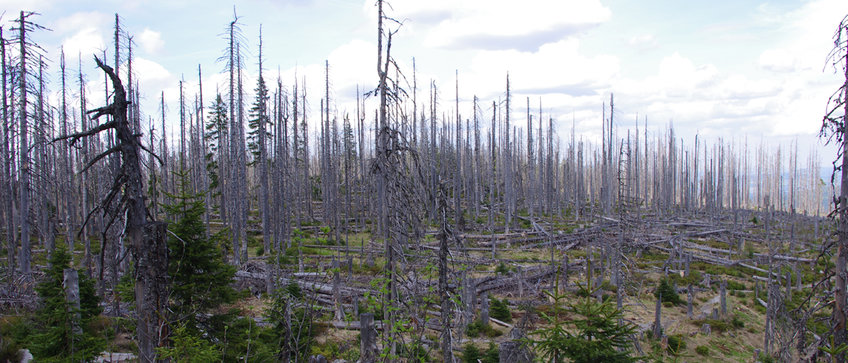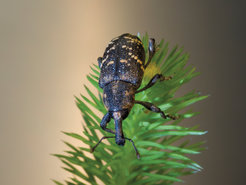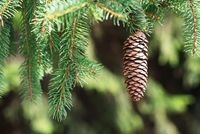
Herbivore and Pathogen Induced Defense Strategies in Conifers
Although our understanding of plant defense mechanisms has grown rapidly in recent years, most of the new knowledge has been obtained from studies on herbaceous species, especially the model plants Arabidopsis thaliana, Medicago truncatula, tomato, potato, maize and rice. Much less is known about the types of defenses employed by woody plants. Consequently, it is not clear if the deployment of chemical defense in woody taxa is fundamentally the same as that in herbaceous plants. Woody plants are usually larger and live longer than herbaceous plants, have a different life history as well, and thus may be subject to different patterns of herbivore and pathogen pressure. In addition, woody plants have unique tissues, such as those resulting from secondary growth of the stem, and so may require different modes of protection.
In order to gain a complete picture of defense in the plant kingdom, it is essential to know more about the defenses of a variety of woody plants, both angiosperms and gymnosperms. Conifers are a distinctive and widespread group of woody gymnosperms whose 500-600 species include some of the largest and longest-lived representatives of the plant kingdom. They are a significant climax species, dominating most of the major forest ecosystems of Europe, Asia and North America. Of the 8-9 recognized families, the largest and geographically most widespread is the Pinaceae which includes Pinus, Abies, Larix, Pseudotsuga, and Picea.
As a model species for studying conifer defense, we have chosen Picea abies (Norway spruce), the most abundant and economically-important conifer species in northern and central Europe. Much is already known about the herbivore and pest problems of P. abies, and this information will be valuable in studying its defense mechanisms. In our group, we are examining the induced chemical defenses of P. abies, defenses whose levels increase following herbivore or pathogen attack. Induced defenses have attracted much attention in recent years because of their widespread occurrence in plants. We study the induction of several different classes of induced defenses in P. abies, including terpene-containing resins and phenolic compounds. Our focus is not only on their defensive roles, but also on how the levels of these compounds may be manipulated by biochemical and molecular methods while minimizing other phenotypic changes. Manipulation of defense compounds in intact plants is a valuable approach to examining their ecological role in the plant.
Role of endosymbiotic gut bacteria of Hylobius abietis in detoxification of terpenes

The pine weevil (Hylobius abietis) is a major pest in European conifer forests where adults feed on the bark and cambium of Norway spruce and pine seedlings. Conifers are protected against bark-feeding herbivores by a complex mixture of secondary metabolites, mainly terpenoid-based oleoresins, and phenolic compounds. Therefore, adult pine weevils must cope with a complex mixture of noxious secondary metabolites in their diet, in addition to the problem of utilizing a food source that mainly consists of lignocellulose.
Many insects are known to harbor symbiotic microorganisms in their digestive system that allow the host to subsist on suboptimal diets by enhancing digestion efficiency, supplementing the diet with limiting vitamins or amino acids, or detoxifying plant secondary metabolites. However, little is known about degradation of lignin or mono-, and sesquiterpenes, as well as diterpene resin acids, the components of coniferous resin by symbiotic microorganisms.
We are exploring how the pine weevil copes with high concentrations of terpenes present in the host bark and cambium, by elucidating the metabolic fate of these compounds and their effect on the beetle. In order to understand the possible role of gut microorganisms in terpene detoxification as well as in wood digestion, we are using culture-dependent and -independent methods as well as metabolic and genomic analyses to functionally characterize the pine weevil’s gut microbiota. Elucidating the fate of terpenes in this system will shed some light on how insects cope with plant induced defenses and how some symbionts allow their hosts to exploit otherwise inaccessible food sources.
Regulation and evolution of terpene resin formation in transgenic spruce

Diterpene resin acids (DRAs) are secondary plant metabolites abundant in the needles and bark resin of many conifers. DRAs are implicated as defensive compounds that protect conifers such as Picea abies (Norway spruce) from the pathogenic fungi Ceratocystis polonica, and from Ips typographus (bark beetle), which functions as a vector for fungal pathogens to enter the plant while feeding. In some populations of Norway spruce, bark beetle attacks leave few trees relatively unscathed while devastating the rest. DRA biosynthesis differs from other areas of terpene metabolism due to the cooperative actions of conifer-specific subfamilies of diterpene synthases and cytochrome p450 enzyme lineages. Both subfamilies are thought to form the committed steps of DRA biosynthesis. Significant advancements in our understanding of DRA biosynthesis have been made in the past. However, the relationship between DRA regulation and pathogen resistance remains out of reach; in regards to attack by bark beetles, it is unknown if either diterpenoid composition or total diterpenoid content in bark can function as a predictor of resistance. A second open question that we are investigating is how new relationships between multiple enzyme families are formed during the evolutionary process; considering the stepwise characteristic of mutation, it is unclear how diterpene synthases and cytochromes p450 evolved committed biochemical relationships that appear to be unique in Norway Spruce and its relatives. This project aims to answer these questions using a combination of transgenic Norway Spruce trees, bark chemical analyses, in vitro biochemical studies, and a diverse set of evolutionary analyses.
Regulation of terpene biosynthesis in isoprene emitting woody plants

Isoprenoids are the most functionally and structurally varied group of plant metabolites and perform a large variety of functions. All isoprenoids like monoterpenes, chlorophylls, and carotenoids originate from the head-to-tail condensation reaction of the five-carbon unit isopentenyl diphosphate (IDP) and its allylic isomer dimethylallyl diphosphate (DMADP). One of the key enzymes in the biosynthetic pathway is the isopentenyl diphosphate isomerase (IDI) catalyzing the isomerization reaction between the two isoprenoid precursors IDP and DMADP. But isoprenoid biosynthesis varies among plants. Woody plants from the Salicaceae and Pinaceae are known to emit also the hemiterpene isoprene, which makes the regulation and channeling of isoprenoid biosynthesis more complex than in other non-isoprene emitting plants which don’t have this biosynthetic pathways branching from DMADP.
To get more insights into the regulation of isoprenoid biosynthesis and to identify the biosynthetic steps controlling the formation of different isoprenoid classes, we will compare a species that emits high quantities of isoprene and low levels of other isoprenoid metabolites, the gray poplar (Populus canescens), with Norway spruce (Picea abies), a species making only low amounts of isoprene but large quantities of isoprenoid metabolites like volatile terpenes. To alter isoprene emission, IDI has been targeted in a transgenic approach to generate transgenic poplar and spruce lines that show either overexpressed or silenced IDI expression levels. Transgenic lines will be characterized in detail regarding the emission of isoprene and the accumulation of other volatile and nonvolatile isoprenoid metabolites. In addition, the expression of genes and activity of the respective enzymes involved in isoprenoid biosynthesis will be investigated. Further, ecological experiments are planned to see if isoprene may contribute to the plant's defense reactions against herbivores and pathogens as well as metabolic flux analysis to see if the transgenic lines show different incorporation rates of 13CO2. By a detailed characterization of the transgenic plants, we hope to contribute to a better understanding of how isoprene emission and isoprenoid production are linked within the plant's biosynthetic machinery and if they are involved in plant defense.
Cooperation partners
Jörg Bohlmann (University of British Columbia, Michael Smith Laboratories, Vancouver, Canada)
Monika Hilker (FU Berlin, Institute of Biology, Dept. of Applied Zoology/Animal Ecology, Berlin, Germany)
Trygve Krekling (Norwegian University of Life Sciences, Dept. of Plant and Environmental Sciences, Ås, Norway)
Paal Krokene (The Norwegian Forest and Landscape Institute, Forest Health, Ås, Norway)
Nina Elisabeth Nagy (The Norwegian Forest and Landscape Institute, Forest Health, Ås, Norway)
Marco Michelozzi (Institute of Plant Genetics, Divisions Florence, Florence, Italy)
Christian Paetz (Max Planck Institute for Chemical Ecology, NMR group, Jena, Germany)
Jörg-Peter Schnitzler (German Research Center for Environmental Health (Munich, Germany)
Armand Séguin (Canadian Forest Service, Laurentian Forestry Centre, Quebec, Canada)


